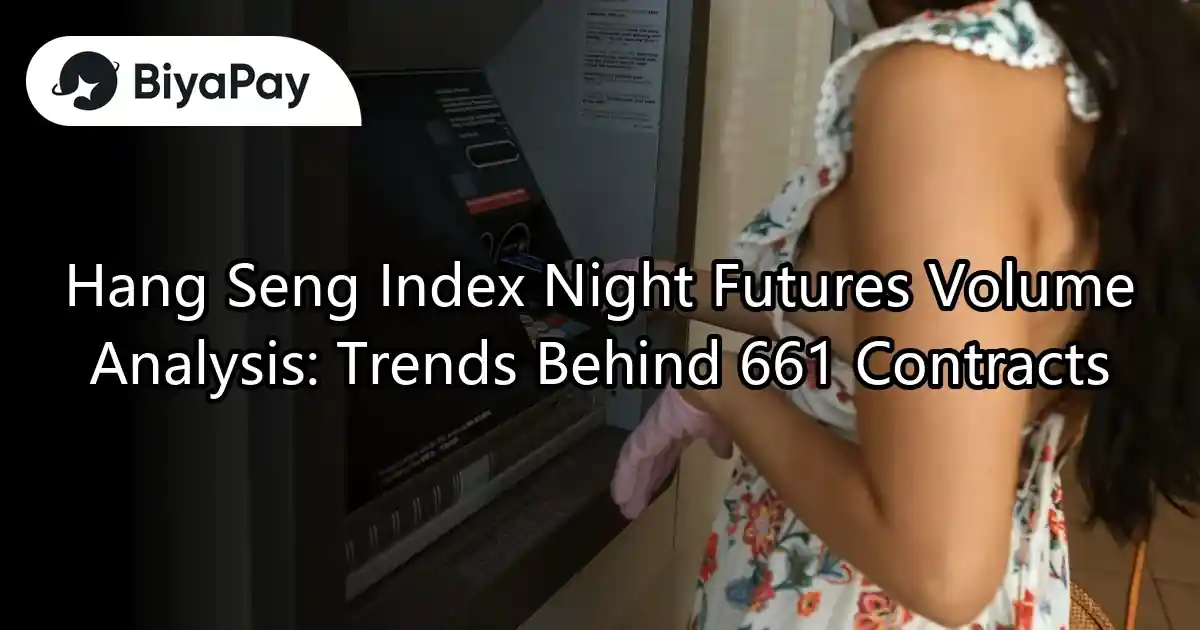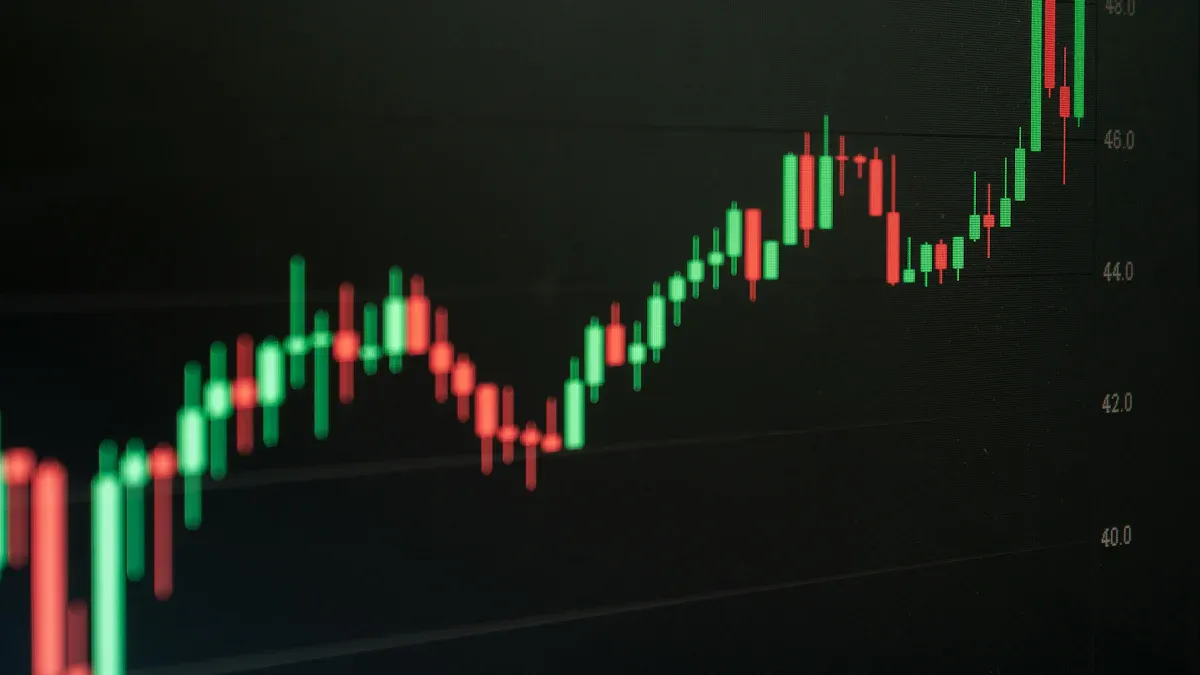- EasyCard
- Trade
- Help
- Announcement
- Academy
- SWIFT Code
- Iban Number
- Referral
- Customer Service
- Blog
- Creator
Hang Seng Index Night Futures Volume Analysis: Trends Behind 661 Contracts

Image Source: pexels
The data highlight of 661 contracts has attracted widespread market attention. This figure shows that the trading volume of Hang Seng Index night futures has experienced significant changes recently, reflecting investors’ sentiments and expectations for the market. The increase in trading volume may be closely related to macroeconomic data, policy changes, or the linkage effects of international markets. Investors can analyze this data to understand short-term market fluctuation trends and adjust investment strategies to address potential risks.
Key Points
- The trading volume of 661 contracts indicates increased activity in the Hang Seng Index night futures market, reflecting changes in investor sentiment.
- Changes in trading volume are closely related to macroeconomic data, policy changes, and international market dynamics, which investors should closely monitor.
- Major market participants include institutional investors, hedge funds, and individual investors, whose behavioral patterns directly affect trading volume.
- The trading volume of the night futures market is typically higher during the initial opening period and near the closing period, which are critical times for investors to adjust strategies.
- Investors should utilize data analysis and risk management tools to flexibly respond to market fluctuations and prepare for long-term investments.
Overview of Hang Seng Index Night Futures Volume

Image Source: pexels
Data Highlights of 661 Contracts
The 661 contracts in trading volume for Hang Seng Index night futures have become a recent market focus. This data indicates that the activity level in the night futures market is increasing, particularly against the backdrop of heightened global economic uncertainty. According to historical data, changes in trading volume are often closely related to market sentiment. Past data on trading volume, transaction prices, and transaction values show that when market volatility intensifies, night futures trading volume typically rises significantly. This data not only reflects investors’ expectations for the market but also provides an important basis for judging buying and selling opportunities.
Moreover, technical analysis indicates that changes in the trading volume of the night futures market can reveal overall stock market trends. For example, when trading volume continues to increase, it may suggest that the market is optimistic about future trends. Conversely, a decline in trading volume may indicate a lack of market confidence. Therefore, the appearance of 661 contracts in trading volume may suggest that the market is entering a new phase of volatility.
Behavioral Patterns of Major Market Participants
The major market participants in Hang Seng Index night futures include institutional investors, hedge funds, and individual investors. Institutional investors typically use the night futures market for risk hedging, particularly during market volatility periods after daytime trading ends. Hedge funds tend to use night futures for short-term arbitrage operations to generate profits. In contrast, individual investors’ participation is mostly based on predictions of market trends, hoping to gain additional returns through night futures trading.
The behavioral patterns of these participants directly impact trading volume. For example, when institutional investors increase hedging operations, the trading volume in the night futures market often rises significantly. Meanwhile, high-frequency trading by hedge funds further drives trading volume growth. Although individual investors’ participation is relatively smaller, their trading behavior can also influence trading volume during periods of significant market volatility.
Time Distribution Characteristics of Trading Volume
The trading volume of Hang Seng Index night futures has distinct time distribution characteristics. According to market data, the peak periods for night futures trading typically occur during the initial opening period in the evening and near the closing period. These two periods account for a higher proportion of the overall trading volume, reflecting the strongest trading intentions of investors during these times.
The high trading volume during the initial opening period in the evening mainly stems from investors’ reactions to the day’s market performance. They quickly adjust investment strategies based on the daytime market performance and the latest international market dynamics. The increase in trading volume near the closing period is related to investors’ position adjustments, particularly before the release of important economic data or policies.
Additionally, the distribution of trading volume is influenced by international markets. For example, the opening hours of the U.S. stock market partially overlap with the trading hours of Hang Seng Index night futures, making U.S. market fluctuations directly affect night futures trading volume. Therefore, investors need to closely monitor market dynamics during these periods to more accurately seize trading opportunities.
Market Trends of Hang Seng Index Night Futures
Impact of Macroeconomic Data
Macroeconomic data has a significant impact on the trading volume and market trends of Hang Seng Index night futures. Investors typically adjust their trading strategies based on the performance of economic indicators, especially in the night futures market. Below are some key indicators and their data:
| Indicator | Value | Year-on-Year Growth |
|---|---|---|
| Industrial Value Added (Above Designated Size) | 10.4% | August 2013 |
| Total Retail Sales of Consumer Goods | 18,886 billion yuan | 13.4% |
| Fixed Asset Investment (Excluding Rural Households) | 262,578 billion yuan | 1.61% (Month-on-Month Growth) |
| Real Estate Development Investment | 52,120 billion yuan | 19.3% |
This data shows that the stable growth of the Chinese economy provides support for the market, particularly the growth in industrial value added and real estate investment, reflecting the activity level of the economy. Investors in the night futures market typically judge short-term market fluctuations based on these indicators. For example, when industrial value added grows significantly, market sentiment may become more optimistic, thereby driving an increase in the trading volume of Hang Seng Index night futures.
Role of Policy Changes in Market Sentiment
Policy changes are an important factor affecting market sentiment, especially in the night futures market. Recent policy events have had a significant impact on market sentiment:
- The phone call between Trump and Xi Jinping signaled a possible easing of trade negotiations, leading to market sentiment turning optimistic.
- The 10-year government bond yield rose from a low of 4.318% to 4.395% due to improved market sentiment.
- Statements from Federal Reserve officials indicate a cautious outlook on the economy, suggesting that policy uncertainty may affect market sentiment.
These policy events indicate that market sentiment is highly sensitive to policies. When policies release positive signals, investor confidence typically rises, thereby increasing trading volume in the night futures market. Conversely, policy uncertainty may lead investors to adopt more conservative strategies, reducing trading activity.
Linkage Effects of International Market Dynamics
The dynamics of international markets have a significant impact on Hang Seng Index night futures. The linkage between Asian and U.S. stock markets is particularly evident, with the following research findings:
- The linkage between Asian and U.S. stock markets becomes more pronounced during financial crises.
- The correlation between the Taiwan stock market and major international stock markets provides data to verify the linkage effect.
- Long-memory and structural change models have analyzed the correlation between international stock markets, further supporting the existence of linkage effects.
These research findings show that fluctuations in international markets directly affect the trading volume of Hang Seng Index night futures. For example, U.S. stock market trends are typically reflected in the night futures market, especially during the hours after the U.S. market opens. Investors need to closely monitor international market dynamics to more accurately predict night futures market trends.
Performance of Industries and Sectors in Night Futures

Image Source: unsplash
Trading Trends of Technology Stocks in Night Futures
Technology stocks in the Hang Seng Index night futures have attracted significant market attention. The innovation capacity and rapid growth of the technology sector draw a large number of investors. In the night futures market, the trading volume of technology stocks typically increases significantly during major technological breakthroughs or corporate earnings releases. Investors use night futures trading to position themselves early and seize potential market opportunities. According to data, the trading volume of technology stocks in night futures rises in sync with fluctuations in U.S. technology stocks, reflecting the linkage effect of international markets. The high volatility of technology stocks makes them a popular sector in the night futures market, especially for stocks related to artificial intelligence and semiconductors.
Performance and Driving Factors of Financial Stocks
The performance of financial stocks in Hang Seng Index night futures is stable and influenced by policies and interest rate changes. The performance announcements of Hong Kong banks and interest rate adjustments are the main drivers of financial stock trading in night futures. When interest rates rise, the trading volume of bank stocks typically increases, as investors expect higher bank profits. Additionally, the trading volume of financial stocks in night futures is influenced by international markets, such as policy changes by the U.S. Federal Reserve. The stability of financial stocks makes them an important sector in the night futures market, attracting institutional investors for risk hedging.
Participation of Other Industries
In addition to technology and financial stocks, the participation of other industries in Hang Seng Index night futures is also noteworthy. Energy stocks see significant increases in trading volume during fluctuations in international oil prices, reflecting investors’ sensitivity to the energy market. The trading volume of consumer goods industries in night futures is influenced by Chinese consumption data, particularly in retail and food sectors. The trading volume of real estate stocks in night futures is typically related to real estate policies and investment data. The participation of these industries shows the diversity of the night futures market, providing investors with more options.
Future Outlook for Hang Seng Index Night Futures
Market Trend Predictions Based on Data
Predicting the future trends of Hang Seng Index night futures requires analysis based on historical data and market trends. Past trading data shows that the trading volume of the night futures market is closely related to macroeconomic indicators, policy changes, and international market dynamics. When economic data performs steadily and the policy environment is favorable, market sentiment is typically optimistic, driving an increase in night futures trading volume.
Additionally, technical analysis tools such as moving averages and volume indicators can provide valuable references. For example, when the trading volume of the night futures market consistently exceeds the average level, it may indicate that the market is entering an active phase. Investors should closely monitor these data changes and combine them with market news to make more accurate predictions of future trends.
Potential Risks and Coping Strategies
The potential risks in the night futures market mainly stem from policy uncertainty, international market fluctuations, and unexpected economic data performance. Below are some common risks and coping strategies:
- Policy Risk: Policy changes may affect market sentiment, leading to increased volatility. Investors can use risk transfer tools, such as trade credit insurance, to reduce losses.
- Market Volatility: The linkage effect of international markets may amplify fluctuations in the night futures market. Monte Carlo simulations and sensitivity analysis can help investors assess the risk impact under different scenarios.
- Unexpected Economic Data: When economic data falls short of expectations, the market may experience sharp reactions. Investors can build decision trees to analyze different response options and choose the best strategy.
These methods can help investors more effectively manage risks and ensure the stability of their investment portfolios.
Long-Term Development Direction and Investment Suggestions
In the long term, the development of the Hang Seng Index night futures market will benefit from the sustained growth of the Chinese economy and the linkage effects of international markets. Past data shows stable growth in corporate revenues and export performance, providing a solid foundation for the market. Although short-term volatility may occur, companies with strong competitiveness still have long-term investment value.
Investors should focus on industries with innovation capabilities and stable profitability, such as technology and financial sectors. These industries perform prominently in the night futures market and are expected to continue attracting capital inflows in the future. Additionally, diversified investments and periodic portfolio adjustments are effective strategies for addressing market uncertainty.
Overall, the long-term development prospects of the Hang Seng Index night futures market are optimistic. Investors should remain patient, combine data analysis and risk management tools, and formulate investment plans tailored to their needs.
The trading volume of 661 contracts reveals multiple trends in the Hang Seng Index night futures market, including the impact of macroeconomic data, the role of policy changes, and the linkage effects of international markets. These trends reflect fluctuations in market sentiment and changes in investor behavior.
Investors should closely monitor changes in the trading volume of the night futures market, particularly during policy announcements or periods of international market volatility. This data can help investors more accurately predict market trends and adjust investment strategies to address potential risks.
In the future, the development of the night futures market will continue to be influenced by multiple factors. Investors should remain flexible, combining data analysis and risk management tools to prepare for long-term investments.
FAQ
What are the trading hours for Hang Seng Index night futures?
The trading hours for Hang Seng Index night futures are from 5:15 PM to 3:00 AM the next day on each trading day. This period covers the main trading hours of European and American markets, providing investors with more trading opportunities.
Who are the main participants in the night futures market?
The main participants in the night futures market include institutional investors, hedge funds, and individual investors. Institutional investors typically use it for risk hedging, hedge funds focus on short-term arbitrage, and individual investors trade based on market predictions.
Why is the trading volume of the night futures market important?
Trading volume reflects the market’s activity level and investors’ sentiment. High trading volume typically indicates heightened market attention to future trends, providing an important basis for investors to judge market trends.
How do international markets affect Hang Seng Index night futures?
Fluctuations in international markets, particularly U.S. stock market trends, directly impact Hang Seng Index night futures. The U.S. market’s opening hours partially overlap with night futures, so investors need to closely monitor international market dynamics.
How can investors manage risks in the night futures market?
Investors can adopt diversified investment strategies and use technical analysis tools like moving averages to judge market trends. Additionally, closely monitoring policy changes and economic data helps anticipate potential risks.
In 2025, the Hang Seng Index night futures’ 661-lot trading volume signals heightened market activity and sentiment shifts, with investors navigating macro-economic data and global market linkages, but traditional bank cross-border fees up to 7.45% can limit trading flexibility—how can you enhance global transaction efficiency and cost-effectiveness? BiyaPay offers an all-in-one financial platform, enabling seamless trading of Hong Kong and US stocks without offshore accounts, helping you capture night futures opportunities and diversify risk.
Supporting USD, HKD, and 30+ fiat and digital currencies, real-time exchange rate tracking ensures cost transparency, while global remittances to 190+ countries feature transfer fees as low as 0.5%, far below traditional bank charges, with swift delivery to meet digital investment needs. A 5.48% annualized yield savings product, with no lock-in period, balances liquidity and steady returns. Sign up for BiyaPay today to pair Hang Seng night futures insights with BiyaPay’s global financial solutions, creating an efficient, low-cost investment experience!
*This article is provided for general information purposes and does not constitute legal, tax or other professional advice from BiyaPay or its subsidiaries and its affiliates, and it is not intended as a substitute for obtaining advice from a financial advisor or any other professional.
We make no representations, warranties or warranties, express or implied, as to the accuracy, completeness or timeliness of the contents of this publication.




Contact Us
Company and Team
BiyaPay Products
Customer Services
is a broker-dealer registered with the U.S. Securities and Exchange Commission (SEC) (No.: 802-127417), member of the Financial Industry Regulatory Authority (FINRA) (CRD: 325027), member of the Securities Investor Protection Corporation (SIPC), and regulated by FINRA and SEC.
registered with the US Financial Crimes Enforcement Network (FinCEN), as a Money Services Business (MSB), registration number: 31000218637349, and regulated by FinCEN.
registered as Financial Service Provider (FSP number: FSP1007221) in New Zealand, and is a member of the Financial Dispute Resolution Scheme, a New Zealand independent dispute resolution service provider.



















